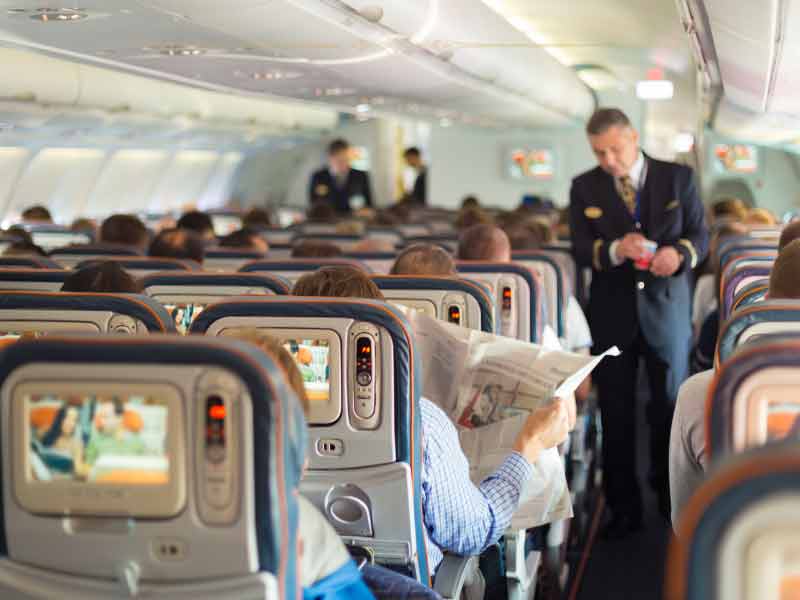In the ever-evolving world of travel, a peculiar new trend is gaining altitude among adventurous flyers. Dubbed “rawdogging,” this practice is challenging travelers to experience long-haul flights in a radically minimalist way. But what exactly is rawdogging, and why is it causing such a stir in the travel community?

Rawdogging a flight involves embarking on a journey without any of the usual amenities or distractions that most passengers consider essential. This means no books, no music, no movies, no snacks, and sometimes even no sleep or water. Essentially, it’s you, your thoughts, and the drone of the aircraft engines for hours on end.
The trend has gained traction on social media platforms, with travelers sharing their experiences of enduring flights lasting anywhere from 7 to 11 hours without any form of entertainment or comfort. Proponents argue that it offers a unique opportunity for introspection and mindfulness in our hyper-connected world.
However, as the trend gains altitude, medical professionals and mental health experts are sounding the alarm about potential risks, especially on longer flights. Dr. Elena Rodriguez, a aviation medicine specialist, explains, “While short periods of introspection can be beneficial, prolonged sensory deprivation in a confined space can lead to anxiety, disorientation, and in extreme cases, panic attacks.”
The origins of the term “rawdogging” are somewhat controversial, originally referring to engaging in an activity without protection. In the context of air travel, it’s been repurposed to mean flying without the protective buffer of distractions and comforts.
Proponents of the trend, like 28-year-old software engineer Jake Thompson, describe it as a transformative experience. “It’s like a digital detox on steroids,” Thompson says. “For the first time in years, I was alone with my thoughts for hours. It was uncomfortable at first, but then incredibly liberating.”
However, critics argue that the trend is little more than a social media stunt, potentially dangerous, and inconsiderate to fellow passengers and crew. Flight attendant Sarah Chen shares her perspective: “We’ve had instances where passengers practicing this refuse all services, including water. It’s concerning from a health and safety standpoint, and it can make our job more challenging.”
Mental health professionals have mixed views on the practice. Dr. Aisha Patel, a clinical psychologist, warns, “For individuals with underlying anxiety or trauma, extended periods without distraction can be triggering. It’s not a one-size-fits-all experience, and people should be cautious about trying this, especially on long flights.”
On the other hand, mindfulness coach Mark Williams sees potential benefits: “In our overstimulated world, the ability to sit with our thoughts is becoming a lost art. Rawdogging a flight, if approached mindfully, could be a powerful exercise in self-awareness.”
The trend has also sparked debate about the nature of modern travel. Travel writer Emma Scott notes, “There’s something to be said for experiencing a journey fully, rather than just trying to make time pass. But there’s a balance to be struck between mindfulness and basic comfort.”
Airlines have had varied responses to the trend. While some see it as a non-issue, others are concerned about the potential health risks of passengers refusing food and water for extended periods. A spokesperson for a major airline, who wished to remain anonymous, stated, “We respect our passengers’ choices, but we also have a duty of care. We’re monitoring the situation closely.”
Travel psychologist Dr. Robert Chen suggests a more moderate approach: “Instead of going to extremes, travelers might benefit from designated ‘unplugged’ periods during their flight, alternating with times when they engage in gentle, mindful activities or necessary self-care.”
For those intrigued by the concept but wary of the extremes, experts suggest a modified approach. This could involve periods of quiet reflection interspersed with light reading, gentle stretching, or mindful eating. The key is to find a balance that promotes wellbeing without risking physical or mental health.
Nutritionist Lisa Fong emphasizes the importance of staying hydrated during flights, regardless of personal challenges. “The low humidity in aircraft cabins can lead to dehydration quickly. Refusing water for an entire long-haul flight can have serious health consequences,” she warns.
As the debate continues, travel industry experts are divided on whether rawdogging will become a lasting trend or fade away as quickly as it appeared. Travel analyst John Davis predicts, “We might see a more moderate version of this trend stick around, as travelers seek ways to make their journeys more meaningful and less automated.”
Whether you’re intrigued by the idea of a distraction-free flight or firmly in the camp of in-flight entertainment, the rawdogging trend has undoubtedly sparked important conversations about how we travel and engage with our surroundings.
As with any new trend, particularly one involving health and wellbeing, it’s crucial to approach rawdogging flights with caution. Consulting with a healthcare provider before attempting any extreme practices during travel is always advisable.
In the meantime, the aviation industry and mental health professionals continue to monitor the trend closely, balancing passenger autonomy with safety concerns. As we navigate this new territory in air travel, one thing is clear: the conversation about how we experience long journeys is far from over.
Whether rawdogging flights will become the next big thing in travel or simply a passing fad remains to be seen. But it has undoubtedly challenged our perceptions of what it means to be a passenger in the modern age of air travel.
As travelers, we’re constantly seeking new ways to make our journeys more meaningful, comfortable, or efficient. The rawdogging trend, while extreme, reflects a broader desire to reclaim our time and attention, even at 30,000 feet.
So the next time you board a long-haul flight, you might find yourself pondering: to rawdog or not to rawdog? Whatever you choose, remember that your wellbeing should always be the top priority. Safe travels!





What a load of nonsense. Who cares. Just make the kids stop screaming/kicking/running and that idiot behind me shut up. I WANT to shut the world out on ANY flight. People can’t fathom behaving in public.